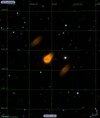Q: (L) There was something else I wanted to ask about. (Andromeda) What about that humming sound that we all heard awhile back in the office?
A: Electrical charge.
Q: (L) How come we can't measure things like that?
A: Everything else including instruments are within the system.
Q: (Perceval) They said electrical charge... (L) Then you can't tell that a charge is different from anything... (Perceval) What we heard in the office was coming from the computer amp, but... (Mr. Scott) Well, but it's like if you measure the voltage between something and the earth, if the charge of both is increased, the voltage will be the same but the total charge on both can be much higher. But you can't tell because you're using a device that can only measure the difference between two points. (L) Belibaste, what's your question about the companion star grounding that you mentioned earlier? (Belibaste) In a previous session, it was said that the companion star coming closer induced a grounding of the sun. I simply wanted to know more precisely how this grounding occurs. For example, is there some kind of electric connection between the sun and the companion star, and if so, which kind of current transits between those two celestial bodies?
A: Indeed, but that occurs "outside" the system.
Q: (Belibaste) That's what you said, Ark. That it's a kind of wormhole...
A: Wormhole is good!
Q: (Belibaste) At the level of the sun, can we say that the reason for this grounding is the reduced positive overall charge?
A: Yes.
Q: (Belibaste) Okay, this reduced positive charge induces a reduced field that increases gravity?
A: Yes.
Q: (Belibaste) And this increase in gravity explains why there are less solar winds expelled from the sun although there is increased cometary activity?
A: Yes.




